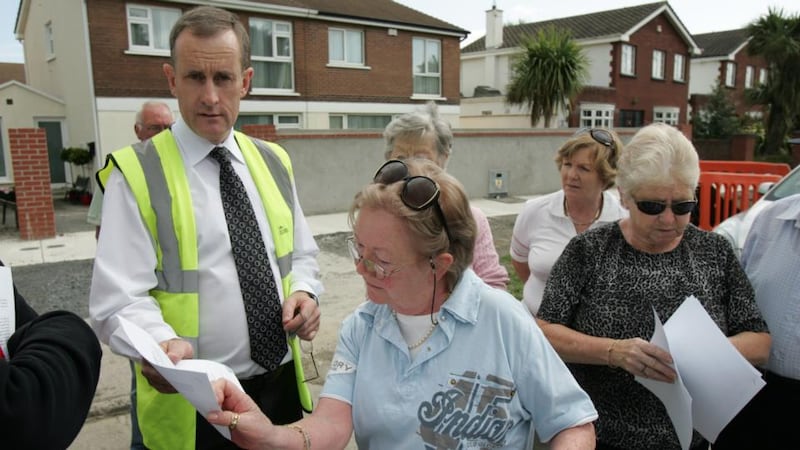Twenty years ago when Owen Keegan was appointed as assistant city manager in charge of housing with Dublin Corporation (as it then was), you could almost hear the shockwaves running through the local government system.
Never before in living memory had an “outsider” bagged such a high position. Yet the local appointments commission had selected Keegan for the job, ahead of internal candidates, even though he was an economist with Davy Kelleher McCarthy.
The new broom was anything but conventional. He regularly cycled to work from Stillorgan, even though he had a parking space in the basement of the Civic Offices at Wood Quay – and this was at a time when cyclists were regarded as cracked.

In 1993, Keegan was the only official in the housing department who had a personal computer on his desk. At the time, information technology in the city administration – the “bunkers” then – was primitive and communications technology non-existent (apart from telephones).
Keegan discovered that the corporation had 88 rent offices on housing estates where tenants went to pay their rent. So he went to An Post and negotiated a deal whereby they could pay in any post office. And when the rent collectors found out, they went on strike.
“Let them strike – we don’t need them anymore”, was Keegan’s attitude. So they went out on the picket line, not getting much support, but the trade unions had such a stranglehold that the council caved in and agreed to redeploy them all.
Dublin City Council, which Keegan this week was appointed to head, is still hugely overmanned. It still has 5,700 staff for a population of 577,000 in the city. Admittedly, some of the services it provides – water and fire brigade – are shared with the other three local authorities in Co Dublin and further afield.
Tough job
However, Dún Laoghaire- Rathdown County Council manages to provide services for its population of 206,000 with a staff of about 1,000 – after numbers were cut by 28 per cent during Keegan's tenure as county manager. He'll have a tough job trying to do that in the city.
Dún Laoghaire-Rathdown was also the first local authority in Dublin to privatise the collection of domestic refuse, at Keegan’s initiative. To him, as an economist, it made sense – even though Siptu, which represented the workers, objected strenuously to the move.
He was also the first county manager to ask if the first Croke Park deal on public sector reform was actually delivering the goods. In January 2012, he described his own experience of trying to bring about changes in staff leave levels as “very disappointing”.
He is now returning to Wood Quay after seven years in Dún Laoghaire. Previously, he had served as the city council's first director of traffic, bringing to the role a critical eye for managing, rather than simply catering for, the growing volumes of traffic during the boom.
Keegan will be remembered as the “traffic tsar” who introduced wheel-clamping for illegally parked cars and for his combative approach to what he saw as misguided attacks on his, and the council’s, restrictive policies.
On one occasion, in the run-up to Christmas, Pat Kenny complained on his RTÉ radio programme about the long queues he had encountered at multi-storey car parks when he tried to find a place to put his car and wondered what Owen Keegan was going to do about this problem.
Within minutes, the director of traffic was on the phone to Kenny, explaining that the reason there had been long tailbacks at city centre car parks was because too many people – including the broadcaster himself – had driven their cars into town. Game, set and match!
Liberal free parking
Keegan even took on the Garda Síochána over the liberal free parking for members' privately owned cars outside Pearse Street Garda station, and reached an "informal agreement" in 1999 that this should be limited to two rows; obviously, there has been slippage since.
In the teeth of vocal opposition from the AA among others, all warning that it would result in chaos, he was centrally involved in the 1999 introduction of a quality bus corridor on the N11-Stillorgan Road. It was to prove an outstanding success by slashing bus journey times.
In 2003, he came out in favour of London-style charging to drive within the area bounded by the M50 to reduce traffic volumes in the city, which had already been cut by 12 per cent as a result of better management – even though it was still growing in the suburbs.
A lateral thinker, Keegan gave his backing in 2009 to plans for Dublin's first bus rapid-transit route linking the Dart station at Sydney Parade with Sandyford Business Park, running via St Vincent's University Hospital, the RTÉ campus at Montrose and UCD in Belfield.
He said the project, co-sponsored by Dún Laoghaire-Rathdown County Council, offered "excellent value for money" at €33 million – a fraction of the cost of a Luas line. But it was not taken on board by the National Transport Authority, then still pursuing more grandiose plans.
Speaking at a Public Affairs Ireland conference recently, he queried why the number of councillors in Dún Laoghaire-Rathdown was being increased by 43 per cent (from 28 to 40) under local government reforms at a time when virtually everything else was being cut back. "A common feature of public service reform programmes is that, generally, the individual measures are not costed. This creates the impression that the costs are insignificant, which is rarely the case," he said, adding that aspects of Croke Park II "may well be inconsistent".
Owen Keegan represents a huge difference in style over his taciturn predecessor, John Tierney, who now heads Irish Water. He has talked about the need for “very strong and determined leadership”, but will need to carry the councillors with him to bring about real change.









